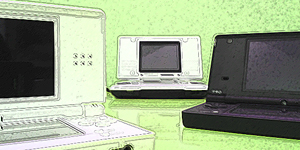Extra: Lost in Translation
Nintendo knows quirky. This is the company that brought us the zany microgames of WarioWare, the man child fairy that is Tingle, and the concept of a dinosaur-riding plumber saving a world of fungi people. Yet sometimes, Nintendo’s games can be too quirky for their own good. This, coupled with technical limitations and other demographic differences, has resulted in a number of interesting Nintendo-published games never making it out of Japan. It’s nothing new for Nintendo fans, who have long fought to see certain games get Western releases. Most recently, fan’s efforts for an Earthbound re-release in North America, along with endless petitions to bring Xenoblade Chronicles, The Last Story, and Pandora’s Tower stateside, were met with success. But for every successful localization story, there are just as many intriguing games that never see an English release. Below, we look at three such games that would have been worth checking out if Nintendo of America gave us the opportunity.
Captain Rainbow
By far the quirkiest game of the bunch is Captain Rainbow, a Wii title that follows a washed up TV superhero who wants to be famous again. The only way he can restore his reputation is by helping Nintendo’s lesser known and almost equally washed up characters. This is where the weirdness begins: the Devil of Devil’s World insists on becoming the world’s top evildoer, a group of soldiers from Advance Wars are dying to learn volleyball, an inexplicably obese Little Mac of Punch-Out!! fame wants to lose weight, and Takamaru of The Mysterious Murasame Castle (and more recently, Nintendo Land attraction Takamaru’s Ninja Castle) needs to stop getting nosebleeds around women. And that’s just the tame stuff. Captain Rainbow also gets raunchy with some more recognizable characters, specifically Mario-baddie-turned-Yoshi-love-interest Birdo. In Captain Rainbow, Birdo uses excessive profanity and even sends Captain Rainbow on a quest to find a certain type of toy that shatters the innocence of the Mario universe. When you couple this more adult humor with the game’s heavy usage of Mario and Zelda references, it becomes clear why it never left Japan.

The downside of Captain Rainbow staying Japan exclusive is that we miss out on a legitimately good game. It was developed by Skip Ltd., who previously worked on the Chibi-Robo franchise and the Japan-only GameCube title GiFTPiA. Like the developer’s previous efforts, Captain Rainbow combines action-adventure gameplay with social interactions. There is a colorful cast of characters who all have their own unique traits and offer a variety of humorous dialog. As in Chibi-Robo, the game revolves around a day and night cycle that impacts not just the game world, but the activities and chatter of the characters themselves. Beyond gameplay similarities, numerous Chibi-Robo references are also included, including a role for Tao the dog. It’s unfortunate that Captain Rainbow never made it stateside, but not a surprise. Reviews out of Japan noted the title’s vulgarity and unless Nintendo of America were to redo significantly large portions of the game, there is no way it would mesh with the family-friendly images that the likes of Birdo, Little Mac, and Nintendo itself have on this side of the Pacific.
Kiki Trick
Captain Rainbow may be the quirkiest game Nintendo ever released, but the Wii’s Kiki Trick takes the title of downright weirdest. Hailing from the same crazy minds that brought us WarioWare and Rhythm Heaven, Kiki Trick offers a variety of minigames that require players to listen and respond. In the main game, players listen to a distorted conversation and then complete tasks about it. These include filling in missing words, determining the answer to a character’s question, or simply transcribing a sentence heard in a noisy settings. More variety is available through the numerous minigames, which task players with figuring out the ingredients of a noodle dish based on its eater’s slurping sounds, knowing when to attack a karate master’s enemies only by hearing their approaching attacks, and helping a doctor determine his patients’ ailments by reconstructing their EKG heartbeat tests.

Clearly, Kiki Trick does not share any of Captain Rainbow’s localization hurdles. It may be weird in concept, but there’s certainly nothing raunchy or culturally questionable about it. Unfortunately, that does not necessarily make a North American release any easier. The game’s heavily reliance on dialog, both prerecorded speech and written responses, would have needed to be redone for English speaking audiences – a daunting task with no guarantee of success. Nintendo made a similar move when re-crafting many of Professor Layton’s brain teasers for Western gamers, but those were sure bets as Layton was already a huge hit in Japan and has seen continued success in the US. Kiki Trick, however, would have been a much bigger gamble. While the Kiki Trick team’s WarioWare series always sells well in North America, its other franchise, Rhythm Heaven, has underperformed. And in Japan, Kiki Trick itself did not make any impact on the charts. The game is certainly an interesting experiment, but for financial reasons, it’s one us Western games can’t try without importing.
Tomodachi Collection
Animal Crossing isn’t Nintendo’s only quirky life simulation game. Swap out the animal villagers for Miis, mix in a little of The Sims, and you’ve got Tomodachi Collection (a.k.a. Friend Collection). Originally released on Nintendo DS in 2009, Tomodachi Collection lets players import or customize their own Mii and then set it loose on the game’s self-contained island. Players don’t actually control the Mii directly, but instead interact with it and the other island inhabitants, including other imported or custom-created Miis. Through thought bubbles, the player’s Mii will say when it wants food, clothes, or specific items. Give the Mii what it wants and its happiness will go up, allowing the player to then teach it songs and phrases, unlock new items, and unlock new attractions around the island. Each action the player makes also earns money, which acts as another way to unlock goodies. Additionally, every Mii in the game has an in-depth bio that shows individual likes and dislikes, nicknames, relationship statuses (yes, Miis can get together), and even blood types. As more of the game world opens up through unlockables and special events based on the real-time calendar, there will be more activities for players and their Miis to do.

The game sounds like a perfect mix of Animal Crossing and The Sims, but there is one defining feature holding it back from a Western release: speech. Using the DS’s built-in microphone, players are able to teach their Miis words and sentences to say. The same speech engine is also used for text-to-speech functions, allowing for other Miis in the game to literally speak to players in quirky, robotic voices. It really takes the gibberish of Animal Crossing’s residents to a whole new level. Unfortunately, this is the exact reason why Tomodachi Collection has been stuck in Japan. Even though the game is a multimillion seller, the speech engine that powers all of the voice interactions is currently limited to Japanese. As creator Yoshi Sakamoto explained to 1UP.com back at E3 2010, “The problem is that we only built Japanese language generation into the software, and that’s a very important part of the game. We can’t make it work with English, so we won’t be able to release the game here.” Luckily, there is a sliver of hope as Sakamoto went on to say, “…this seems like something we might be able to revisit once more powerful hardware comes along.” Good thing that a sequel, Tomodachi Collection: New Life, was just released in Japan on the more powerful 3DS hardware.
What does the future hold?
Captain Rainbow, Kiki Trick, and Tomodachi Collection are all examples of what makes Nintendo’s non-AAA games so great: interesting ideas, quirky settings, and unique gameplay. Unfortunately, in a marketplace where distribution and marketing suck away what little profits these games may make, Nintendo felt it was not worth bringing them out of Japan. The good news, however, is that the risk/reward scale is shifting. Thanks to the eShop, Nintendo is now able to release more experimental titles without worrying about distribution, large marketing campaigns, or even demographic concerns. This has already resulted in the localization of oddball games such as the 3DS’s full motion video-infused Tokyo Crash Mobs, and can be a great way to release titles such as Kiki Trick or even more ‘adult’ humor games such as Captain Rainbow. The recent addition of Nintendo of America CEO to Nintendo Global President Satoru Iwata’s list of duties also bodes well for the localizations of games that required additional efforts in the past. In his new role, Iwata is making a noted effort to streamline Nintendo’s global operations and align its product releases, which means that Tomodachi Collection may finally get the resources it needs for a proper English language makeover. The future is certainly bright for a single, global game lineup from Nintendo. Let’s just hope it’s not without its quirks.



